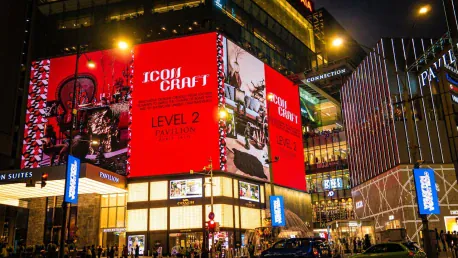Indoor advertising in shopping malls continues to prove its effectiveness, even amidst the growing dominance of digital marketing in the consumer landscape. Despite the widespread adoption of online shopping, mall advertisements have managed to capture significant consumer attention and drive purchasing decisions effectively. This article explores the strategies and impacts of indoor advertising within shopping malls, emphasizing its role in engaging consumers and enhancing sales outcomes.
The Impact of Indoor Advertising on Consumer Recall
High Recall Rates Among Shoppers
Research reveals that an impressive 80% of mall shoppers remember seeing advertisements within the mall environment. This recall rate is significant when compared to other advertising mediums like television or billboards. The immersive experience of shopping malls, where consumers are surrounded by a mix of retail and leisure activities, provides a conducive atmosphere for brand engagement.
The presence of a diverse array of retailers and entertainment options within malls augments the visibility of indoor advertisements, making them more memorable to consumers. The ambient atmosphere of a mall complements the advertising strategy, fostering a space where consumers are already inclined to spend money. This distinct advantage over other advertising platforms underscores the enduring efficacy of mall ads in capturing consumer attention and recall.
Influencing Purchase Decisions
Of those who recall seeing mall ads, 62% are influenced to make a purchase. This statistic underscores the impactful nature of indoor advertisements, which not only capture attention but also convert it into tangible sales. The interactive and immediate nature of mall advertising allows consumers to see, touch, and even try the products, enhancing their buying experience.
Shopping malls provide a unique environment where consumers can interact with products in real-time, compare them across different brands, and make informed purchasing decisions. This physical interaction often leads to higher conversion rates as consumers are more likely to buy products they have personally examined. Thus, indoor advertising within malls serves as a pivotal tool in driving immediate consumer action, setting it apart from digital or broadcast advertising.
Demographic Analysis of Advertising Effectiveness
Generation X and Frequent Mall-Goers
Generation X and frequent mall visitors show the highest engagement with mall advertisements. Sixty-eight percent of Generation X shoppers and 70% of individuals who visit malls often are the most affected by these ads. These demographics appreciate the convenience and immediate gratification of in-person shopping, making them prime targets for indoor advertising strategies.
The insights into Generation X’s purchasing preferences reveal their strong inclination toward physical shopping experiences. This demographic values the ability to physically inspect and compare products, which, in turn, makes them more responsive to mall advertisements. Additionally, frequent mall-goers’ familiarity and comfort with the mall environment further enhance their receptiveness to indoor ads, making these consumers particularly valuable to marketers.
Gender-Specific Insights
Men are notably influenced by mall ads, with 73% indicating a preference to inspect products in-store before making online purchases. This behavior highlights the role of mall advertisements in bridging the gap between physical and online shopping, providing a tactile experience that online retailers cannot match.
The significant percentage of men who prefer in-store inspection of products underscores the unique advantage that malls have over online shopping platforms. The ability to physically interact with products before finalizing a purchase decision is a critical factor that influences consumer behavior. Mall ads effectively leverage this preference, offering detailed product information and visuals that guide consumers toward making informed purchasing decisions.
Comparative Analysis: Indoor vs. Other Advertising Mediums
Indoor Advertising vs. Television and Billboards
When comparing the effectiveness of indoor advertising to television and billboards, mall ads stand out. Consumers find mall ads more engaging and less intrusive compared to TV commercials. The strategic placements within the mall, such as entrance doors, building facades, and illuminated panels, provide continuous exposure, enhancing brand visibility.
The nature of indoor advertising within malls allows for repeated exposure to brand messages, significantly increasing the chances of consumer engagement and retention. Unlike television commercials, which can be skipped or muted, or billboards that are often glanced at briefly, mall ads remain in the consumers’ line of sight throughout their shopping journey. This prolonged exposure contributes to higher recall rates and a deeper impression of the brand.
Shopper’s Interaction with Advertisements
Mall ads benefit from the shopper’s mindset, which is already geared toward spending. Unlike other advertising mediums that compete for attention during various activities, mall ads have the undivided attention of the consumer, poised to make purchasing decisions.
The shopping mall environment attracts consumers who are intentionally seeking new products and deals, making them more receptive to advertisements. Mall visitors are typically in a purchasing mindset, open to brand messages and offers that align with their shopping intentions. This unique consumer context maximizes the impact of mall ads, converting attention into actionable consumer behavior.
Preferred Sales Channels and Consumer Preferences
Physical Stores vs. Online Shopping
A significant 68% of shoppers prefer to examine products in physical stores even if they plan to buy them online. This trend is more pronounced among frequent mall-goers (74%) and men (73%). The tactile experience of physical stores plays a pivotal role in the decision-making process for these consumers.
The in-store inspection provides a sensory experience that online shopping cannot replicate, reinforcing the importance of physical retail spaces. Consumers appreciate the opportunity to try, feel, and see the products in person, which builds trust and confidence in their purchasing decisions. This preference for physical stores underscores the continued relevance of mall advertising in driving both in-store and online sales.
Popular Product Categories
Groceries, men’s clothing, and accessories are primarily purchased in-store by the respondents. With 80% buying groceries and 70% opting for in-store purchases of men’s clothing, malls remain critical shopping destinations for these categories. This behavior underscores the vital role malls play in providing immediate access to a range of products.
Consumers’ reliance on malls for essential and non-essential goods highlights the strategic importance of indoor advertising. By effectively targeting these popular product categories, mall ads can influence a wide audience, catering to both everyday needs and occasional purchases. The strategic placement of ads for these categories ensures maximum visibility and consumer engagement, driving sales within the mall environment.
Strategic Placement of Advertisements within Malls
Maximizing Visibility
Ads placed at strategic locations such as entrance doors (58%), building facades (57%), and illuminated panels (54%) are most effective. These positions ensure maximum consumer exposure during the shopping journey, reinforcing brand messages repeatedly.
The strategic positioning of advertisements throughout the mall facilitates a continuous brand presence, keeping the brand top-of-mind as consumers navigate the mall. Entrances and high-traffic areas offer prime real estate for ads, capturing consumer attention immediately upon entry and throughout their shopping experience. This ensures consistent engagement with the brand, increasing the likelihood of conversion.
Prominent Ad Types
Consumers find offers and discounts (65%) and product presentations (34%) most useful. These types of advertisements appeal directly to the consumer’s need for deals and information, prompting both impulse buys and planned purchases.
The effectiveness of offers and discounts in mall ads is driven by consumers’ natural inclination toward value-seeking behavior. Ads that highlight promotions or special deals effectively capture consumer interest, encouraging immediate action. Product presentations provide detailed information, helping consumers make informed choices and reinforcing their purchasing decision within the mall setting.
Future of Mall Advertising
Increasing Consumer Interest
The interest in purchasing items showcased through mall advertisements is growing. Forty-eight percent of respondents consider buying products they see in mall ads, with an even higher interest among Generation X at 84%. This willingness to spend indicates that mall ads successfully tap into consumer desires and needs.
The growing interest in mall advertisements reflects their ability to resonate with modern consumer behavior, blending the advantages of physical and digital shopping experiences. By addressing consumer needs directly within the shopping environment, mall ads create compelling opportunities for engagement and sales. This trend suggests a promising future for mall advertising as a vital component of comprehensive marketing strategies.
Role of Malls in Launching Products
Despite the rise of digital marketing in today’s consumer landscape, indoor advertising in shopping malls remains remarkably effective. Online shopping has seen widespread adoption, but advertisements within malls continue to capture significant consumer attention and strongly influence purchasing decisions. This enduring effectiveness can be attributed to several factors. For one, the physical presence of an ad in a high-traffic area naturally draws the eye and engages consumers in a way that digital ads often can’t. Moreover, mall-goers are typically in a shopping mindset, making them more receptive to marketing messages.
Indoor mall advertising employs a variety of strategies to ensure its impact. From eye-catching banners and interactive kiosks to digital screens and promotional events, these ads create a multi-sensory experience that can profoundly affect consumer behavior. Such strategies are designed not just to attract attention but to enhance the overall shopping experience, making consumers more likely to make a purchase.
In summary, despite the digital shift in marketing, indoor advertising in shopping malls continues to play a crucial role in engaging consumers and boosting sales, confirming its enduring value in today’s market.









